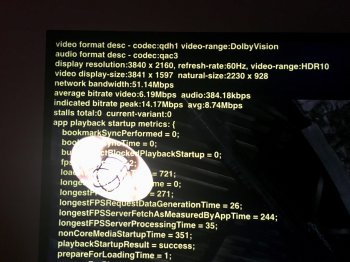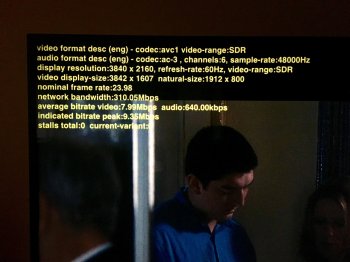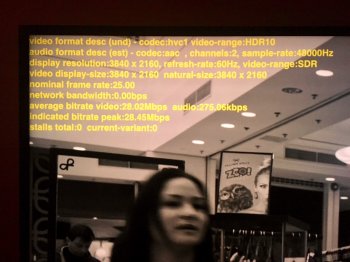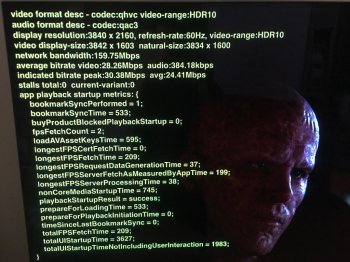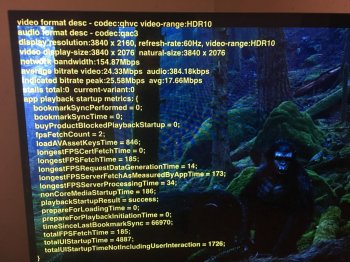Looks like Apple has some tricks up his sleeve with this iTunes Store streaming.
What I have noticed so far:
1) First of all, I would not be surprised they use their homebrewn HTTP Live Streaming protocol as the backbone. It definitely seems to scale the picture according to available bandwidth.
2) It will stream different content, based on HDR or SDR setting in Audio & Video settings
3) It seems to use some unknown codec designations: qdh1 for HDR/DV content, qhvc for SDR content and qac3 for surround audio
4) HDR content seems to arrive in Dolby Vision format and is locally translated into HDR10 if display does not support DV (like mine).
I draw these conclusions from my tests with the developer mode media info display.
Here is the stream info for a
purchased movie when aTV is in 4k HDR mode:
View attachment 722473
You notice, that incoming video is in Dolby Vision and in qdh1 codec. Its size is 2230x928 which is expanded to UHD display size (3840x1597, 2,4:1 aspect ratio)
Here the same stream, now my aTV is in 4K SDR mode:
View attachment 722472
Everything almost unchanged, except that video comes now in in SDR rendering, in qhvc codec.
Obviously, video size is downgraded proportionally to network bandwidth. My 55,11Mbps is less than half of JWort93's 124,95Mbps and my incoming frame size is smaller than his. Accordingly, video bitrate is only 1/3 of his (9Mbps vs 25Mbps).
Just for fun, same data for 2 clips from my local hard drive, served via iTunes Home Sharing.
Regular FHD movie (1080p)
View attachment 722470
You can see standard codecs - avc1 and ac3, SDR rendering, incoming 1920x800 frame is upscaled to display size of 3842x1607 (2,4:1 aspect ratio).
My own 4K HDR10 file in HEVC:
View attachment 722471
Still standard codecs hvc1 and aac, HDR10 rendering, source frame is unscaled, so displayed frame has same size of 3840x2160.
Important to note - since incoming video range is HDR10 but outgoing range is SDR (aTV video output was set to 4K SDR), all chroma is lost an my telly displays a black-and-white image!


